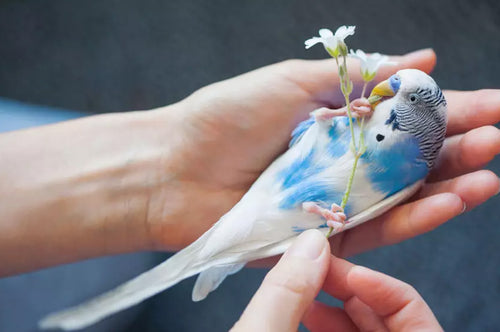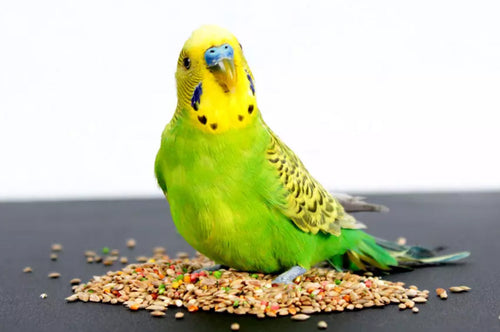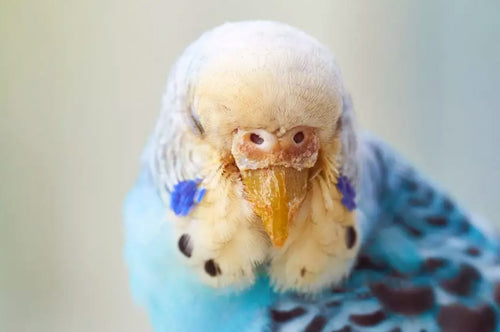Family & Budgie Health
To ensure healthy budgies, provide a clean cage, a balanced diet, daily exercise, and plenty of mental stimulation.


Allergies & Diseases from Caged Birds
Budgies and Asthma
People prone to asthma will be affected by budgies. In severe cases the presence of a bird in the same room as the sufferer will bring on the wheezing and other symptoms, and the only solution is for that person to leave the room. Asthma sufferers with a less severe condition should be fine near budgies, but may start to show symptoms if the bird is free-flying. This general asthmatic problem is not to be confused with the condition known as Allergic alveolitis, described below.
Allergic alveolitis is a bronchial disease that occasionally affects humans, usually after several years’ contact with birds. This has earned it the name ‘pigeon fancier’s lung’, as a homage to those dedicated people who spend lots of time in pigeon lofts with their prized birds. It could just as easily be called ‘budgie fancier’s lung’, though, and does indeed have yet another name, ‘budgerigar (or parakeet) dander pneumoconiosis’. The cause of the problem is dust from bird feathers and dried droppings. Once the asthma-like symptoms have manifested, continued exposure to the birds will make the condition worse. In its chronic form, if the sufferer has failed to stop breathing in the irritant, the process can no longer be reversed, and lung capacity will be permanently diminished.


Can Humans Catch Diseases From Budgies?
In brief, yes. But not very often!
Parrot fever or psittacosis is a bronchial disease commonly found in parrots. It is a common ailment, known as Chlamydiosis in general, or ornithosis when relating to birds. The disease usually lies dormant, without provoking symptoms in the bird, but can still be passed on via droppings or saliva and other bodily fluids, or in body dust (dander) shaken from the feathers. In humans, ingesting or inhaling a dose of the Chlamydiophila psittaci bacteria responsible for the disease can, if you’re unlucky, lead to illness.
The word ‘unlucky’ is very appropriate, as many people work with birds all their lives without ever showing any symptoms of the disease. But it still pays to be cautious. Always wash your hands after handling budgies or washing their cages.
Manifestations of parrot fever in humans range from flu-like symptoms and a sore throat to high fevers and diarrhoea.
Giardia is one of several intestine-incubated nasties found in birds, and is similar to the more well-known salmonella. It is transmitted via birds’ droppings, and can therefore contaminate cages, budgie water supplies and the surrounding ground (if your birds are outside). Diarrhoea-like symptoms hail the onset of a rapid decline and death in birds. Humans who contract the disease will suffer gastro-intestinal problems too.
Budgie Health Check
If you keep lots of budgies in an aviary, it will be harder to spot individual problems, so always be on the lookout.
Like many animals, budgies are frustratingly good at hiding illness until it’s far advanced.
This makes sense in the wild, where an ill-looking creature will soon be spotted and picked off by a predator.
Once you’ve identified an ill bird, a trip to the vet should always be your priority, and you should never delay in the hope of saving money on vet’s bills.

Budgie Disease Symptoms
- An increase in lethargy
Unless asleep, not even the most timid of budgies will spend a long time silent and motionless.
The first signs of lethargy might be when he shows a lack of interest in the things that usually stimulate him – you, new food, his mate, etc. - Sleeping during the day
This could be due to external disturbances during the night.
But if you can rule that out, the sleepiness will be a symptom of illness.
One possibility is an infestation of feather mites, keeping him awake all night with their blood-sucking attentions. - Fluffed up feathers
This means the bird is too cold, and indicates one of two things – either the cage or aviary is a bit chilly, or the budgie is unwell.
A cold budgie may shiver too - Excessive squawking
If your bird is calling out in alarm constantly, he is in distress.
There may be no visible symptom, but if you are sure that there is nothing in the vicinity to cause him great anxiety, you can conclude that he’s in pain. - A change in perching behaviour
A bird who suddenly starts resting on the ground rather than a perch has either hurt a wing or is too weak to perch.
Another, less drastic sign of problems is when a budgie who always sleeps while perched on one leg suddenly perches on two. - A dirty vent
Always a sign of wet or sticky droppings, which usually indicates health problems. - Droppings
You will be familiar with the ‘burnt popcorn’ look of your budgie’s normal, healthy poo.
Anything that deviates from the norm is a sign that something is wrong.
The exception to this is a hen bird during nesting: her droppings may change appearance, and that’s not a sign of illness.
Note: some budgie pellet food contains colouring that dyes droppings.
This is something to avoid, as it makes a healthy poo diagnosis much trickier. - Loose droppings
Sometimes a budgie will acquire a taste for a foodstuff that gives him diarrhoea if eaten in excess, so bear that in mind.
If no such culinary culprit can be pinpointed, wet poo is a symptom of disease or parasites. - Liquid in the droppings
This is normal - budgie’s excrete a small amount of liquid urine, but you might not even notice it, as most of the droppings will be falling onto sawdust or paper.
Excess urine is a cause for concern, though.
It may turn the droppings loose, as mentioned in the previous bullet, but will sometimes be visible as a wet ring around the solid matter.
If there is more of this liquid than usual, talk to a vet. - Discoloured droppings – green
Green droppings in a bird whose poo is usually brown or black indicates that the budgie is not eating enough.
This may be due to stress, or it may be that a young bird is malnourished due to poor diet.
It could also be a symptom of an infection in the bird’s crop. - Discoloured droppings – grey
If the poo is a uniform light grey or grey-brown, your budgie has a problem with his pancreas. - Discoloured droppings – red
A dark red colour in the droppings is probably blood, and results from an intestinal problem
(but always ask yourself if the bird has eaten cherries, red berries or beetroots – these will produce red patches in the poo, and that’s absolutely fine). - Discoloured droppings – green and yellow
This is a symptom of liver disease, and the green colouring is caused by bile. - Undigested food in the droppings
This indicates intestinal parasites.
If the budgie has just been treated for this condition, his system is simply having a clear-out and the problem should disappear in a few days.
If he hasn’t been treated, he needs to be! - Vomiting
Being sick as a result of disease is not to be confused with the common budgie habit of regurgitating seed to a mate/chick or mate/chick substitute.
An ill bird’s vomit will be wet, and will usually make a mess down his chin and breast.
The causes of vomiting are varied, so you need to get a professional diagnosis quickly. - Gummed up nostrils, or nose discharge
A healthy budgie will never have dry or liquid matter sticking to his cere. - Hot feet
This one requires your familiarity with the usual warmth of a budgie’s foot as he perches on your finger: hot feet is often a symptom of illness (kidney problems usually). Note, however, that an obese bird will have hotter feet too, and that one’s down to you – up his healthy food intake, and reduce the fatty seeds or snacks.
A stressed or over-exercised bird will also have hot feet, so wait until he’s calmed down before making a judgement on his health. - Cold feet
This symptom, if it results from illness, will be accompanied by listlessness, ruffled-up feathers and shivering.
Note: a budgie fresh from the bath may have cold feet too, but that’s nothing to worry about. - Swollen or sore eyes
If the area around the budgie’s eye is swollen, or if there is any eye discharge, it needs a vet’s intervention.
The underlying problem could be one of a number of bacterial, viral or fungal infections. - Sticky feathers on head or face
This may indicate an infection of the budgie’s crop.
If this is the case he will be unable to eat and will die very quickly without a vet’s intervention. - Blood on the feathers
This shows that the bird is wounded. He will be feeling weak, and may need antibiotics. - Limping
The budgie has hurt his leg or foot, and will need to be checked to make sure nothing is broken. - Overgrown beak or toenails
This is a sign of disease, often connected with liver problems. - Deformed or misshapen beak
This is the work of burrowing mites, and needs treating if the budgie’s beak – and therefore life – is to be saved. - Rapid breathing
This could be due to overheating; but it is also a symptom of illness.
If the budgie has his beak open all the time, if you can hear any rasping or clicking sounds when he breathes,
or if his tail twitches up and down with every breath, there are problems.

Healthy male budgie.

This female budgie has an infestation of scaly face mites.
Discover our awesome range of bird products.
Swipe for more












